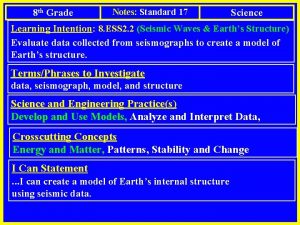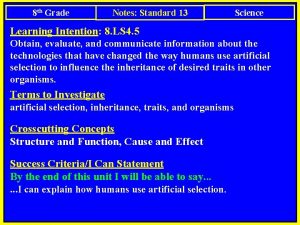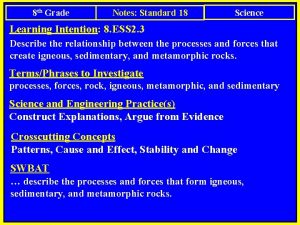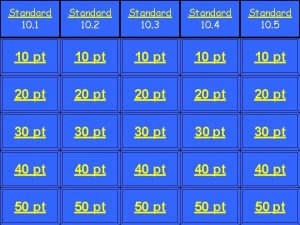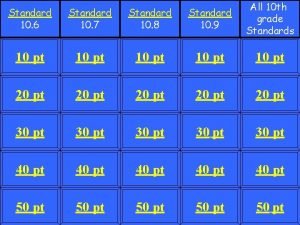8 th Grade Notes Standard 09 Science Learning













- Slides: 13

8 th Grade Notes: Standard 09 Science Learning Intention: 8. LS 4. 1 Analyze and interpret data for patterns in the fossil record that document the existence, diversity, extinction, and change in life forms throughout Earth’s history. Terms/phrases to Investigate Fossil Record, (Bio)diversity, Extinction, Earth’s (Geologic) History Crosscutting Concepts Patterns, Structure and Function, Stability and Change Success Criteria/I Can Statement By the end of this unit I will be able to say. . . I can identify and describe patterns in the fossil record which reveals ancient life forms, structural changes over time, and extinctions.

Notes: Standard 09 8 th Grade Science What Are Fossils? Fossils are the preserved physical remains of deceased organisms that are at least 10, 000 years old NOTE: Most organisms DO NOT become fossils after death NOTE: The formation of fossils is a RARE event Video Clip Link (54 sec): How Fossils Are Made Video Clip Link (1 min 50 sec): What is a fossil? Primate Fossil: 47 million years old Whale Fossil: 25 million years old

8 th Grade Notes: Standard 09 Science Types of Fossils In Rocks Fossils In Amber Petrified Fossils In Asphalt Frozen Fossils Trace Fossils Mold/Cast Fossils Index Fossils

Index Fossils. . . are fossils commonly found at certain strata levels across large geographic areas. They are used to estimate the rock’s age. Examples: Ammonites and Trilobites Ammonite Trilobite Ammonite fossil This invertebrate first appeared in the Devonian period. They went extinct during the Cretaceous. Paleogen mass extinction event. Trilobite fossil This invertebrate first appeared in the Cambrian period. They went extinct during the Permian mass extinction event.

Fossils in Sedimentary Rock Ø Sediment refers to particles of dirt, rock, and organic debris. Sedimentary rock is formed from this. Video Clip Link (2 min 10 sec): Fossils in Sedimentary Rock Video Clip Link (1 min 38 sec): Law of Superposition Bottom layers older. Top layers younger.

Sedimentary Process and Fossils A) Erosion washes away particles of dirt, rock, & organic debris. B) These particles accumulate somewhere else into layers. C) Deceased organisms sometimes accumulate in these layers. D) Under certain rare conditions, these organisms become fossils. E) Over time, layers pile up on top of pre-existing layers. Video Clip Link ( 1 min 51 sec): Sedimentary Rock Formation

Cenozoic Geologic Column F E D C B A Stratigraphy: the science of classifying and interpreting stratified rock formations. Patterns in the strata reveal multiple diversification times followed by multiple mass extinction events. Strata: Another name for rock layers F) Cretaceous-Paleogen Extinction (65 MYA) ---after: life diversified/mammals prospered E) Triassic-Jurassic Extinction: (210 MYA) ---after: life diversified/new life forms appeared D) Permian-Triassic Extinction: (250 MYA) ---after: life diversified and dinosaurs prospered C) Devonian Extinction: (364 MYA) ---after: life diversified/new life forms appeared B) Ordovician-Silurian Extinction: (439 MYA) ---after: life diversified/new life forms appeared A) Cambrian Explosion: (542 MYA) ----fossils of complex organisms appeared in large numbers and types for first time.

How to Interpret the Fossil Record 1) Identify the type of rock: (provides environmental clues) sandstone: formed from sand, siltstone: formed from silt, shale: formed from mud, limestone: formed in shallow oceans, etc 2) Look for index fossils Terrestrial search for ammonites, trilobites, or others. flat teeth/herbivore 3) Examine the fossil’s structure and function Shells, backbones, leg bones fins, beaks, and/or type of legs/backbone teeth, reveal facts about the organism’s environment Aquatic 4) Draw Conclusions Aquatic Index Fossil

Review Questions Be Aware! Multi-Select Question Notes: Standard 09 Review Questions Be Aware! Multi-Select Question False True

Review Questions Notes: Standard 09 Review Questions Vertebrates Trilobites were crab-like organisms with exoskeletons and no backbone. Trilobites (invertebrates)

Review Questions Notes: Standard 09 Review Questions Trilobites were very successful for hundreds of millions of years. They were wiped out during the Permian extinction.

Review Questions Notes: Standard 09 Review Questions

Review Questions Notes: Standard 09 Review Questions
 Conversion notes brutes en notes standard wisc 5
Conversion notes brutes en notes standard wisc 5 Grade 7 term 3 natural science
Grade 7 term 3 natural science Matter and materials (grade 7 worksheets)
Matter and materials (grade 7 worksheets) Grade 9 natural science term 2 notes
Grade 9 natural science term 2 notes The biosphere grade 7 notes
The biosphere grade 7 notes Planet earth and beyond grade 7
Planet earth and beyond grade 7 Natural science grade 7 term 3
Natural science grade 7 term 3 8th science staar review
8th science staar review Science staar review
Science staar review My favourite subject maths for class 4
My favourite subject maths for class 4 Cuadro comparativo e-learning m-learning b-learning
Cuadro comparativo e-learning m-learning b-learning Standard form notes
Standard form notes English language notes grade 11
English language notes grade 11 Grade 7 life orientation test
Grade 7 life orientation test

















